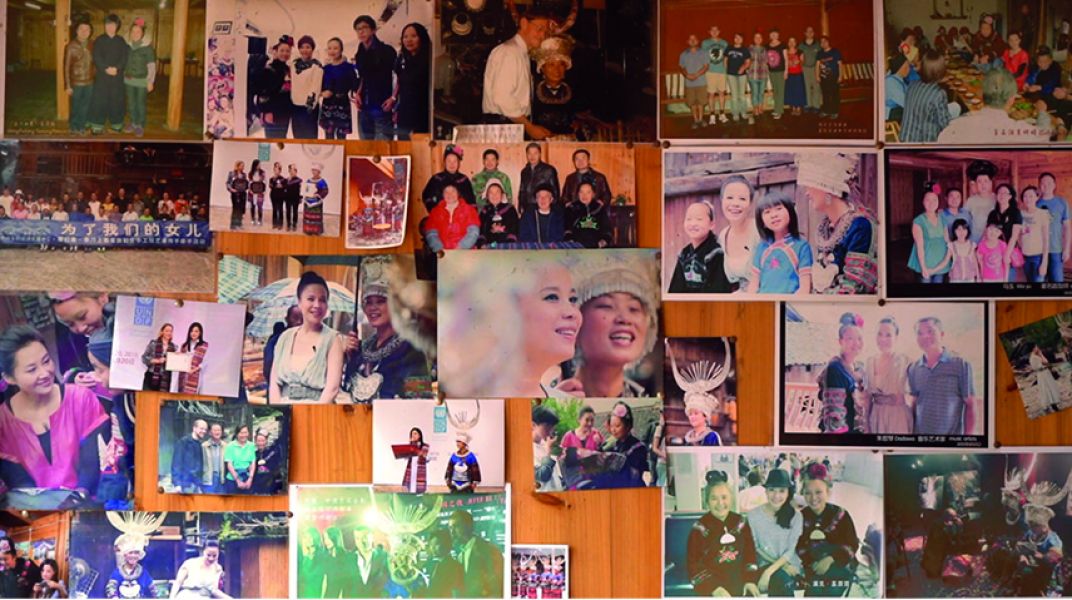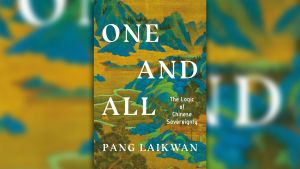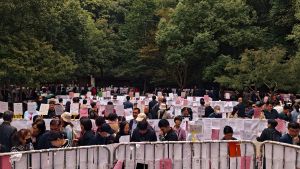
On the Spectacle of Being Our-(Miao)-Selves
As in many other rural villages across China, the 300 or so residents of Upper Jidao in Guizhou Province have been ‘living with tourism’ (to use Hazel Tucker’s 2003 book title) since the early 2000s, when rural tourism development was widely and enthusiastically promoted by the Chinese State as the path to rural poverty alleviation (Chio 2014; Yeh and Coggins 2014). Tourism was already a known phenomenon to Upper Jidao residents since the 1980s, based as they are between the long-established and nationally celebrated ethnic Miao villages of Upper Langde and Xijiang (see Oakes 1998; Schein 2000). Moreover, the fact that Upper Jidao and its surrounds are a majority ethnic minority area—demographically and administratively within Qiandongnan Miao and Dong Autonomous Prefecture (where 82 per cent of the population is registered as either Miao or Dong, see Baidu n.d.) and culturally practised through everyday lifeways and annual festivals (see Chio 2018, 2019; Kendall 2019)—means that, irrespective of one’s individual ethnic identification, residents are well aware of the place of ethnic minorities in the Chinese State’s (shifting) vision of multiculturalism.
In the post-reform era, China’s tourism industry serves economic but also political purposes, effectively functioning as a national marketing campaign to sustain Chinese multiculturalism, at least as far as China’s 55 officially recognised ethnic minority groups are concerned (Han Chinese ethnic tourism is a different beast). To overstate the point just a bit, anyone who has even a marginal proximity to ethnic tourism by now has a clear understanding of the standard vision of how tourism works and what the work of tourism entails for minority peoples in China. This can be summed up as the ‘song and dance’ (歌舞表演): the practised, choreographed, staged spectacle in which everyone has a role as either performer or viewer and through which cultural otherness is to be appropriately appreciated.
The stage for such spectacles of Chinese multiculturalism can be highly produced and televised to serve overtly political goals of social engineering and control, as has been violently foisted on Uyghur communities (Anon. 2021; Harris 2020; Restrepo 2022a, 2022b, 2022c). Or, the venue can be as perfunctory and ad hoc as the front door of a village home in Upper Jidao, where paying tourists request photos of, and sometimes with, women in their festival dress (盛装). In the latter instance, a song or two or a dance step might be desirable but is unnecessary; the patently visible otherness of the heavy, colourful festival clothes completed with a substantial silver headdress suffices. And there is also an in-between in Upper Jidao: the performance of Miao singing and dancing by village residents that continues to delight audiences with its combination of non-professionalism (read thusly as authentic) and obvious choreography (indicating their willingness to perform). The villagers’ performance is booked in advance by tour groups and usually occurs in the main village square. From the fee charged to tour groups, each village participant is compensated based on their level of engagement (see Chio 2014: 68).
It is therefore not particularly contentious to say that ethnic minority people in China, from Upper Jidao to Ürümqi, are highly—sometimes painfully—aware of being looked at, of being a desired object to be seen. But the fact that visual presence is so central to Chinese tourism, and to Chinese multiculturalism more broadly, does not really reveal anything about what the experience of being seen is like, or how it feels to be asked to be looked at. The spectacle of being a Miao self is one that encompasses both the recognition of one’s visual desirability and the navigation of the circumstances when one is seen as Miao.
To put this in more concrete ethnographic terms, while sometimes Upper Jidao women are asked to dress up for photos by tourists who come to the village (which they almost always agree to do for a small fee), they also are occasionally hired or invited to travel outside the village to wear their festival clothes as part of someone else’s marketing or business campaign. The spectacle of oneself as Miao, in other words, is not limited to tourism contexts; for some women in Upper Jidao by the 2010s, being visibly Miao had also become a form of migrant labour, albeit occasional and frequently underpaid. What difference did it make to be spectacularly Miao outside the village, in places as far-flung as an exhibition centre in Chongqing or a fashion show in France? What was it like being seen under these conditions?
Multiculturalism is Good for Business
Chen has since the early 2000s been Upper Jidao’s primary point person for hosting tourists, negotiating with government officials and tour guides, and promoting the village in the media, whether in national outlets or through her frequently updated social media accounts. The third floor of her home comprises guestrooms and shared facilities; the second-floor living room can host more than 60 guests at a time. A wall in Chen’s house—the one immediately facing the doorway into the main living room from the kitchen where one enters—has long been covered with an assortment of photographs. Some are family photos, or at least feature members of her family, but most are what might be best described as photos of Chen’s work in Chinese multiculturalism: Chen in various types of visibly Miao ethnic dress posing with tourists, with other similarly dressed women from the village in the village, or in distinctively other places such as Paris.
Sometimes she and the other women are wearing full Miao festival dress, complete with the ornate, weighty silver headdresses; sometimes she is in what is locally referred to as simply ‘Miao clothes’ (苗衣服): a black velvet top with embroidered flower trim and knotted buttons and usually one’s hair wound up in a top-knot decorated with a flower or two. Chen is in nearly every photograph on the wall; some of those that do not feature Chen are of professional fashion models who once came to Upper Jidao on a shoot for ‘Miao-inspired’ couture or celebrities who have visited the village. The images document her work in tourism, but also the vision of Chinese multiculturalism in which her visible Miao presence, her labour as a Miao female body, has brought her profit, international travel, and expanded socioeconomic networks.
The wall is itself an indication of just how cognisant Chen has become of her visual value; multiculturalism is, in its way, good for business. It is good for her tourism business, to be sure, but also apparently for a hot-pot soup base business (Kaili Red Sour Soup, 凯里红酸汤), as she recounted to me in 2017. During her month-long recovery after giving birth that spring—a rare period when Chen was not busy hosting tourists or preparing to do so—she recuperated in bed as convention required. In lengthy conversations with me, she reflected on the state of the village’s tourism, her ambitions, and her frustrations. What began as a question about what she had been up to other than thinking about tourism, and whether she had grown tired of living in the village, unearthed the story of her short stint working for a soup company in Kaili, the prefectural capital city approximately 25 kilometres from Upper Jidao, where Chen had attended school from a young age through to her vocational nursing training.
Ten years after the experience of working for the company, she retold it with some humour and the faintest touch of pride in her ability to negotiate disappointments and frustrations: her own and those of her fellow villagers who had also gone to Chongqing believing that they would be promoting their village’s tourism. For the soup company’s boss, Chen insinuated, bringing a group of real Miao women from a real Miao place to accompany his promotion of Red Sour Soup from Kaili, the capital of a Miao and Dong Autonomous Prefecture, made very good marketing sense. When the women complained that they had been deceived into promoting his soup, not their own village’s tourism, the boss tried to justify their presence at the exhibition hall by saying they were promoting Miao food, which was a proxy for Miao culture, which was the core of ethnic tourism in Upper Jidao.
Proximity To and Proxy For
On the surface, this is how Chinese multiculturalism works, after all: the presence of visibly distinctive Miao women linked the product—hot-pot sour soup base—to an appreciably, appropriately cultural otherness that was safely ensconced within a consumable product. Advertising the safe consumption of otherness through food is, of course, a cornerstone of global tourism and of contemporary ideologies of race and racialisation (see, for instance, Alkon and Grosglik 2021; hooks 1992). It would require little effort for a customer to enjoy multiculturalism in this form, but it is worth noting that the promotion of Kaili Red Sour Soup did not involve the Miao women engaging with the product. It was not so much about Miao food in the sense of Miao people who might cook, eat, or serve it to others, as about Miao proximity to the food product being promoted. Chen and her fellow villagers being there to be seen in their festival dress was, in many ways, no different than a version of song and dance: staged, with a clear division between who is to be seen and who is supposed to do the seeing, where the performers ultimately function in a supporting role for something else. In Chen’s case, this was a tomato-based hot-pot soup, but it is not much of a stretch to describe the staged song-and-dance shows as proxies for the Chinese nation-state’s unwavering, unquestionable unity.
The disappointment and anger of the women from Upper Jidao in discovering that they were there to promote something other than their own village, other than themselves, was therefore quite reasonable. In this instance, they did not consider themselves in the business of Kaili Red Sour Soup or even of a general idea of Miao food, let alone the broad notion of Chinese multiculturalism, and certainly not for the paltry price of RMB20 a day. They imagined being seen as something much more specific: themselves. When they threatened to leave, Chen convinced them to stay out of a sense of propriety and by likening their experience to tourism; why not just let them look at us, she suggested, while we enjoy our all expenses paid trip to Chongqing?
But why would people want to look at Miao women in festival dress, especially outside a tourism context? Or, more precisely from the perspective of a woman in Miao festival dress, why would people crowd around and stare for so long? What exactly are they looking at, or looking for? In another conversation, these questions did not emerge from a place of naivety about or unfamiliarity with the country’s overwhelmingly Han Chinese majority. Rather, they came from the lived, felt experience of being stared at, of being seen. Wu, another woman from Upper Jidao who had been involved in the village’s tourism for a few years in the early 2000s, recalled to me in 2015 what she remembered of the experience in Chongqing with a laugh and a slight scoff.
By this time, she was no longer living in the village, having moved to the outskirts of Kaili, where she sold soft tofu and sometimes vegetables as a street vendor. The way people had crowded and stared at their festive clothes and headdresses, she said, was the same as when people stared at ‘crazy’ or mentally ill people. But this was obviously not why people stared, Wu said; rather, she figured, Miao silver headdresses were so beautiful that people could not help but stare. Other people, such as the bus passengers in Zhejiang Province on China’s eastern coast where her sister-in-law once also was wearing festival dress, were not used to seeing such intricate and large silver headdresses (or any silver headdresses at all, arguably), Wu reasoned, so of course they would gawk and crowd around, even if it felt to the Miao women (and Wu’s brother-in-law, as she recounted) that they were the ones who might be crazy.
The Discomfort of Being Oneself
These very short, off-the-cuff, and seemingly incomplete reflections by Chen and Wu illuminate two key turns in Chinese multiculturalism today. The first is the ongoing quest—manifest in state policies and pronouncements—to determine just what rural and ethnic minority people in China are and should be doing in the post-reform period. In the 1980s, rural households were meant to transform themselves into enterprises; in the 1990s, rural Chinese became the rural-to-urban migrant labourers (农民工 or, when literally translated, ‘peasant workers’) propelling the country’s urbanisation and economic growth. In the 2000s, to reverse the outflow of rural migrants, the state promoted rural tourism, and rural ethnic tourism, to convince people to stay in place by being rural and ethnic for tourists. Throughout these decades, the common denominator was what to do with rural and ethnic minority people in China, where ‘rural’ and ‘ethnic’ function as the wide default categories of ‘other’ when positioned against the urban, culturally Han Chinese population posited as the desired norm.
The second turn is more affectively loaded. For Wu and Chen, out of their work in tourism emerged their experiences of Chinese multiculturalism: the heat and discomfort of wearing traditional clothes that are designed for winter festivals inside an exhibition centre, for example. Or the silent embarrassment and stubborn dignity of being the object of stares and reasoning with oneself to preserve a sense of self-confidence and self-worth. Or, for Chen and her sister-in-law, the excitement and thrill of travelling to Paris, being photographed under the Eiffel Tower and bright lights of a fashion show, where their purpose was to simply appear, to be seen, not as the centre of attention or the main attraction but, again, in a supporting role, offering through their visible presence the gentle reassurances of a multiculturalism that does not ask too much of the viewer.
This is, perhaps, the most salient and powerful aspect of Chinese multiculturalism today: that it presents itself as a consumable (a soup, a style, a song)—one that requires woefully little effort on the part of the consumer and pretends to ask nothing more of the performer than to simply ‘be yourself’. It functions on the assumption that it cannot be so difficult to be oneself. Be Miao, be female (mostly, but not always, the case; see Schein 2020), and be nearby, Wu and Chen are told. It is not all terrible and it can be rather amusing in retrospect, as both women insinuate in their retellings. But it is, as they say, sometimes quite uncomfortable.
Acknowledgements
Many thanks to Yang Qiao for translation assistance and to the Alexander von Humboldt Foundation and the University of Southern California for the research leave that made writing and video editing possible. Field research and filming were funded by a Fejos Postdoctoral Fellowship from the Wenner-Gren Foundation and a University Research Grant from Emory University.
References





